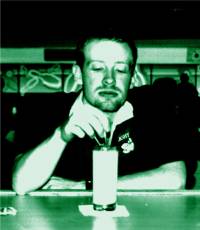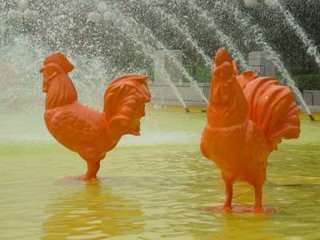I recently read an article by about Vic Braden and the 3-day programs he does at his resort in Utah. One of the things that surprised me about it was that people who come in for these intensive weekends meet a man who is familiar with tactics, and psychology, as well as mechanics, but the focus of a lot of their activity is reshaping mechanics. He thinks that the biggest problems that players have is in their tendency to overdo their strokes, in particular this article talks about the author having a big backswing on her forehand.
This was salient for me because, as a tennis pro, I am often confronted with the idea of minor tweaking, or major reshaping. Most players are understandably reluctant to take on wholesale changes without guarantee of success. My working theory is that there is a ceiling for intermediate players where the most talented of them can reach a low-advanced (I am thinking 4.0) level without hitting topspin, but only a rare talent can rise above this. In fact, I firmly believe that a similarly talented player hitting topspin will win every time, and continue onwards, level-wise.
So anyone who I work with on a consistent basis is going to face learning topspin. I don't think I can help them grow much without it. The primary reason for this is that topspin allows people to attack weak shots from their opponents with a good risk/reward ratio. Obviously, this is because topspin dips the ball into the court and bursts after the bounce, allowing more pace on a deep shot, which is then is more likely to get to the back curtain before it can be tracked down. Additionally, topspinners can keep their swing speed constant (-ly high) whether they are forward in the court or not which allows a player to keep their foot on the gas, so to speak. I find it very difficult for players to vacillate between soft swings and hard swings, and spin helps mitigate that.
Another great advantage of someone who can hit as much Top as they want is the ability to play angles with pace. The more spin, the faster the ball dips, so it becomes much more likely that a person can hit a cross-court passing shot, for example. A flat-hitting player must look for the down-the-line pass nearly every time because it allows them to hit the length of the entire court (to the opposite baseline). If they hit the same pace cross-court, obviously the ball will go wide, so they must slow down the ball in order to keep it in (I am aware that the diagonal shot, corner to corner is longest, but for a Passing shot, the cross-court cannot be aimed to the diagonal corner because the volleyer would easily cover this ball. The available shot must be inline, at the minimum, with the "side T (where the service line hits the sideline," if not closer to the net along the sideline.). Topspin, by making the ball dip, allows for more pace on the crosscourt, as well as a sharper angle. This ability also behooves the baseliner in moving their opponent off-court.
What are the limits of learning topspin? This is always a tough question. Younger is usually better (less habit to work against), as well as people who are not currently involved in a lot of competitive play (old strokes creep in when there is pressure, and it is hard to try new things when there is an obligation to win rather than to try to improve). I often try to get people to add spin to a weaker stroke, or focus on the forehand as a more offensive stroke. I also think it's much easier to hit topspin with a forehand or a two-handed backhand. The one-handed topspin backhand demands the most control over body position, balance, and racquet-face control, and is therefore usually the hardest of the three major groundstrokes to learn topspin with.
I’d also say that spin is much better understood with a headlight frame. Head-heavy racquets mask and even out the various kinds of contact that we make. Spin requires an certain amount of sensitivity to the amount of grip the ball feels from the strings. This translates into a feeling about ratio or spin to power. I can describe the spin part as friction, but struggle for a good word to describe contact that leads to straight-ahead power. "Contact" doesn't seem clear enough. "Impact?" "Bounce?" I'm open to suggestions. Anyway, thick (looking across the string bed from the side), head-heavy racquets absorb so much of the information, that it's hard for a novice to develop any sense of how much friction and bounce they are creating with a given swing; it becomes hard to develop a sense of how hard to swing and at what angle. It's hard to develop confidence.
But that doesn't mean that I haven't been able to get people in their 80s to spin the ball. It just means it harder when one of them uses an "old-lady" racquet that is best suited to generating more power for flat shots.
I continue to believe that a beginner at any age or state of racquet ownership should be taught topspin as long as they can make contact with the ball "every" time. I believe that it is easier in the long-run to learn feel for spin while learning about all the other elements of hitting the ball than later. I don't teach anything to my students that I wouldn't endorse a competitive player doing. I think it is a disservice to show someone something, get them some skill at it, then change the basic feel of the activity by adding spin. At that point, everything changes: the positioning of the body, the location of the racquet in preparation, the angle of the racquet face, the target of the follow-through, as well as the feel of the ball on the strings.
Ergo, a beginner's strokes should be:
-an Eastern to semi-Western forehand
-a two-handed backhand with the dominant hand in Continental
These are the easiest to hit topspin with.
-Continental grip on volleys and overheads
The slice volley is incomparable and all top-flight volleyers are masters of this. It allows a consistent approach to mid-court and low volleys (the two toughest) and allows "regular" volleys to be driven deep into the court with relatively low risk and minimal swing. Topspin volleys are occasionally better at dipping the ball and adding power, but they are very limited in when they are appropriate.
-Continental grip on a slightly slice (sidespin) serve
This was actually one of the last serves I learned well enough to use, but that's because I was stubborn. Now it is a primary serve for me. The common serve that people learn which is flat and with an Eastern forehand grip is crap. It can't be improved on beyond an intermediate level. Pure flat serves are the hardest to get into the box. The harder they are hit, the lower the percentages are. Not so much with the slice. The spin adds a layer of margin for error (This is something I wish I could fully explain to a non-spinner, but I'm not sure I can yet.). It also allows the development of a second serve which is much more difficult to return than a slowed-down flat serve. Good servers don't slow down on the second serve; they just attack with more spin.
By way of summary, I'll say that there are lots of kinds of strokes out there. The best players are the ones who develop strokes that have the highest ceiling. It is important to me to help people work on these strokes rather than spin their wheels beating themselves up because they are trying to improve with strokes that have reached their highest possible level.


